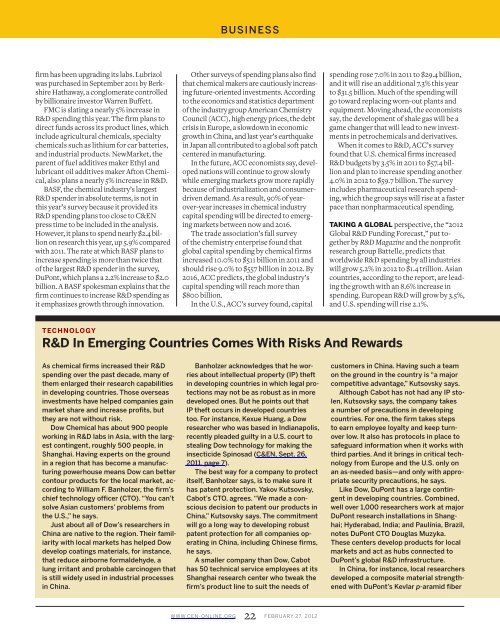February 27, 2012 - IMM@BUCT
February 27, 2012 - IMM@BUCT
February 27, 2012 - IMM@BUCT
Create successful ePaper yourself
Turn your PDF publications into a flip-book with our unique Google optimized e-Paper software.
BUSINESS<br />
firm has been upgrading its labs. Lubrizol<br />
was purchased in September 2011 by Berkshire<br />
Hathaway, a conglomerate controlled<br />
by billionaire investor Warren Buffett.<br />
FMC is slating a nearly 5% increase in<br />
R&D spending this year. The firm plans to<br />
direct funds across its product lines, which<br />
include agricultural chemicals, specialty<br />
chemicals such as lithium for car batteries,<br />
and industrial products. NewMarket, the<br />
parent of fuel additives maker Ethyl and<br />
lubricant oil additives maker Afton Chemical,<br />
also plans a nearly 5% increase in R&D.<br />
BASF , the chemical industry’s largest<br />
R&D spender in absolute terms, is not in<br />
this year’s survey because it provided its<br />
R&D spending plans too close to C&EN<br />
press time to be included in the analysis.<br />
However, it plans to spend nearly $2.4 billion<br />
on research this year, up 5.9% compared<br />
with 2011. The rate at which BASF plans to<br />
increase spending is more than twice that<br />
of the largest R&D spender in the survey,<br />
DuPont, which plans a 2.2% increase to $2.0<br />
billion. A BASF spokesman explains that the<br />
firm continues to increase R&D spending as<br />
it emphasizes growth through innovation.<br />
Other surveys of spending plans also find<br />
that chemical makers are cautiously increasing<br />
future-oriented investments. According<br />
to the economics and statistics department<br />
of the industry group American Chemistry<br />
Council (ACC), high energy prices, the debt<br />
crisis in Europe, a slowdown in economic<br />
growth in China, and last year’s earthquake<br />
in Japan all contributed to a global soft patch<br />
centered in manufacturing.<br />
In the future, ACC economists say, developed<br />
nations will continue to grow slowly<br />
while emerging markets grow more rapidly<br />
because of industrialization and consumerdriven<br />
demand. As a result, 90% of yearover-year<br />
increases in chemical industry<br />
capital spending will be directed to emerging<br />
markets between now and 2016.<br />
The trade association’s fall survey<br />
of the chemistry enterprise found that<br />
global capital spending by chemical firms<br />
increased 10.0% to $511 billion in 2011 and<br />
should rise 9.0% to $557 billion in <strong>2012</strong>. By<br />
2016, ACC predicts, the global industry’s<br />
capital spending will reach more than<br />
$800 billion.<br />
In the U.S., ACC’s survey found, capital<br />
spending rose 7.0% in 2011 to $29.4 billion,<br />
and it will rise an additional 7.3% this year<br />
to $31.5 billion. Much of the spending will<br />
go toward replacing worn-out plants and<br />
equipment. Moving ahead, the economists<br />
say, the development of shale gas will be a<br />
game changer that will lead to new investments<br />
in petrochemicals and derivatives.<br />
When it comes to R&D, ACC’s survey<br />
found that U.S. chemical firms increased<br />
R&D budgets by 3.5% in 2011 to $57.4 billion<br />
and plan to increase spending another<br />
4.0% in <strong>2012</strong> to $59.7 billion. The survey<br />
includes pharmaceutical research spending,<br />
which the group says will rise at a faster<br />
pace than nonpharmaceutical spending.<br />
TAKING A GLOBAL perspective, the “<strong>2012</strong><br />
Global R&D Funding Forecast,” put together<br />
by R&D Magazine and the nonprofit<br />
research group Battelle , predicts that<br />
worldwide R&D spending by all industries<br />
will grow 5.2% in <strong>2012</strong> to $1.4 trillion. Asian<br />
countries, according to the report, are leading<br />
the growth with an 8.6% increase in<br />
spending. European R&D will grow by 3.5%,<br />
and U.S. spending will rise 2.1%.<br />
TECHNOLOGY<br />
R&D In Emerging Countries Comes With Risks And Rewards<br />
As chemical firms increased their R&D<br />
spending over the past decade, many of<br />
them enlarged their research capabilities<br />
in developing countries. Those overseas<br />
investments have helped companies gain<br />
market share and increase profits, but<br />
they are not without risk.<br />
Dow Chemical has about 900 people<br />
working in R&D labs in Asia, with the largest<br />
contingent, roughly 500 people, in<br />
Shanghai. Having experts on the ground<br />
in a region that has become a manufacturing<br />
powerhouse means Dow can better<br />
contour products for the local market, according<br />
to William F. Banholzer, the firm’s<br />
chief technology officer (CTO). “You can’t<br />
solve Asian customers’ problems from<br />
the U.S.,” he says.<br />
Just about all of Dow’s researchers in<br />
China are native to the region. Their familiarity<br />
with local markets has helped Dow<br />
develop coatings materials, for instance,<br />
that reduce airborne formaldehyde, a<br />
lung irritant and probable carcinogen that<br />
is still widely used in industrial processes<br />
in China.<br />
Banholzer acknowledges that he worries<br />
about intellectual property (IP) theft<br />
in developing countries in which legal protections<br />
may not be as robust as in more<br />
developed ones. But he points out that<br />
IP theft occurs in developed countries<br />
too. For instance, Kexue Huang, a Dow<br />
researcher who was based in Indianapolis,<br />
recently pleaded guilty in a U.S. court to<br />
stealing Dow technology for making the<br />
insecticide Spinosad (C&EN, Sept. 26,<br />
2011, page 7).<br />
The best way for a company to protect<br />
itself, Banholzer says, is to make sure it<br />
has patent protection. Yakov Kutsovsky,<br />
Cabot’s CTO, agrees. “We made a conscious<br />
decision to patent our products in<br />
China,” Kutsovsky says. The commitment<br />
will go a long way to developing robust<br />
patent protection for all companies operating<br />
in China, including Chinese firms,<br />
he says.<br />
A smaller company than Dow, Cabot<br />
has 50 technical service employees at its<br />
Shanghai research center who tweak the<br />
firm’s product line to suit the needs of<br />
customers in China. Having such a team<br />
on the ground in the country is “a major<br />
competitive advantage,” Kutsovsky says.<br />
Although Cabot has not had any IP stolen,<br />
Kutsovsky says, the company takes<br />
a number of precautions in developing<br />
countries. For one, the firm takes steps<br />
to earn employee loyalty and keep turnover<br />
low. It also has protocols in place to<br />
safeguard information when it works with<br />
third parties. And it brings in critical technology<br />
from Europe and the U.S. only on<br />
an as-needed basis—and only with appropriate<br />
security precautions, he says.<br />
Like Dow, DuPont has a large contingent<br />
in developing countries. Combined,<br />
well over 1,000 researchers work at major<br />
DuPont research installations in Shanghai;<br />
Hyderabad, India; and Paulínia , Brazil,<br />
notes DuPont CTO Douglas Muzyka.<br />
These centers develop products for local<br />
markets and act as hubs connected to<br />
DuPont’s global R&D infrastructure.<br />
In China, for instance, local researchers<br />
developed a composite material strengthened<br />
with DuPont’s Kevlar p -aramid fiber<br />
WWW.CEN-ONLINE.ORG 22 FEBRUARY <strong>27</strong>, <strong>2012</strong>

















